Голос Талыша |
|---|
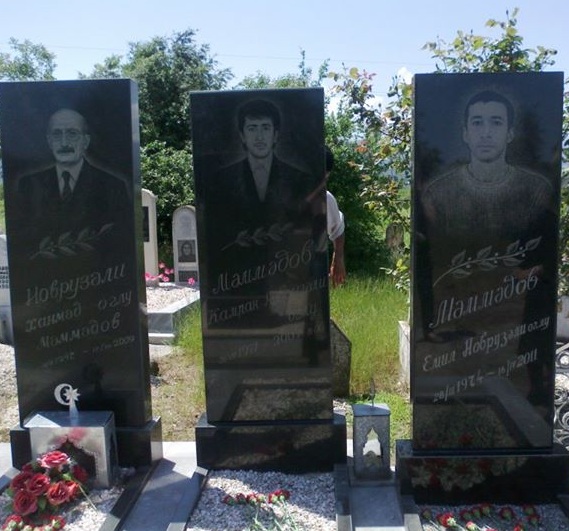 Известные события, произошедшие с моей семьей за последние годы, всколыхнули нашу жизнь до основания.
|
|
Voice of Talysh
В категории материалов: 49
Показано материалов: 41-45 |
Страницы: « 1 2 ... 7 8 9 10 » |
Сортировать по:
Дате ·
Названию ·
Рейтингу ·
Комментариям ·
Просмотрам
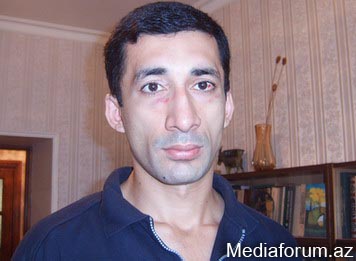 36-aged
Emil Mamedov, the younger son of Professor Novruzali Mamedov, head of
the Talysh Culture Center and the Editor-in-chief of the Tolyshi Sado
(The Voice of Talysh) paper, who died in Prison 15 in Baku after long
persecution and mental pressure, suddenly died in Moscow this morning. 36-aged
Emil Mamedov, the younger son of Professor Novruzali Mamedov, head of
the Talysh Culture Center and the Editor-in-chief of the Tolyshi Sado
(The Voice of Talysh) paper, who died in Prison 15 in Baku after long
persecution and mental pressure, suddenly died in Moscow this morning.
"Evil destiny tracks this family,” the Chairman of the Committee for Novruzali Mamedov’s rights, Hilaal Mamedov said.
|
 Prof.
Hooshang Amirahmadi is the founder and president of
(www.american-iranian.org), holds a Ph.D. in planning and international
development from Cornell University and is a professor of the Edward
J.Bloustein School of Planning and Public Policy, at Rutgers University
Professor Amirahmadi has served as director of the University's Center
for Middle Eastern Studies, as chair and graduate director of his
department at the Bloustein School, and as the University Coordinator of
the Hubert Humphrey Fellowship Program. Dr. Amirahmadi is also a
founder of the Center for Iranian Research and Analysis and served as
its director for many years. He was a candidate for President in the
Ninth Presidential Election in Iran in June 2005, but the conservative
and religious Guardian Council disqualified him for his American
citizenship and democratic platform. Dr. Amirahmadi is also the
president of Caspian Associates, Inc.
(http://www.caspian-associates.com), an international strategic
consulting firm headquartered in Princeton, New Jersey. Prof.
Hooshang Amirahmadi is the founder and president of
(www.american-iranian.org), holds a Ph.D. in planning and international
development from Cornell University and is a professor of the Edward
J.Bloustein School of Planning and Public Policy, at Rutgers University
Professor Amirahmadi has served as director of the University's Center
for Middle Eastern Studies, as chair and graduate director of his
department at the Bloustein School, and as the University Coordinator of
the Hubert Humphrey Fellowship Program. Dr. Amirahmadi is also a
founder of the Center for Iranian Research and Analysis and served as
its director for many years. He was a candidate for President in the
Ninth Presidential Election in Iran in June 2005, but the conservative
and religious Guardian Council disqualified him for his American
citizenship and democratic platform. Dr. Amirahmadi is also the
president of Caspian Associates, Inc.
(http://www.caspian-associates.com), an international strategic
consulting firm headquartered in Princeton, New Jersey. |
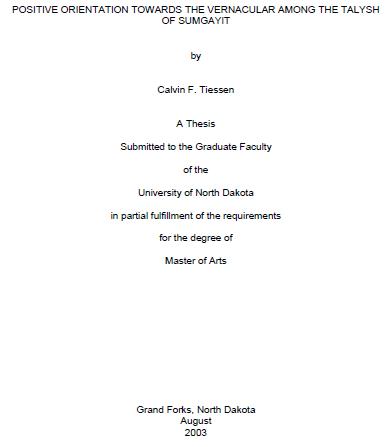 ABSTRACT ABSTRACT
This thesis looks at the identification of positive vernacular orientation in the
Talysh community of the city of Sumgayit, for the purpose of gaining a greater
understanding of its causes. Positive vernacular orientation is defined as exhibition
of a preferred status for the vernacular in sociolinguistic behaviour. Positive
vernacular orientation is described in three areas of sociolinguistic behaviour:
patterns of vernacular language use, vernacular language proficiency and frequency
of vernacular-speaking individuals in social networks. Data was collected through
personal interviews. The questionnaires for these interviews were developed using
a qualitative-relational research approach. The description of positive vernacular
orientation takes the form of a criteria-based typology of which an analysis of
influential factors is ultimately made. This analysis of influential factors
demonstrates the interaction between positive vernacular orientation as described in
the typology and the contextual elements of the family, socio-economic dynamics
and individual attitudes.
A total of 13 types of individuals demonstrating positive vernacular orientation
are identified. Variation in vernacular orientation is shown to pattern itself according
to differences in generation and time of arrival or birth in Sumgayit. |
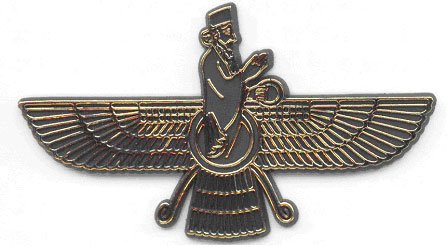 The
formation of Talysh ethnos penetrated different stages, and it has long
history. As one of the earliest foci of human civilization the territory
of Talysh people is rich of the archaeological monuments of ancient
period when people lived in the caves. Under the effects of different
factors the people concentrated in the mountains, gradually began to
realize their generality/community, which led to the formation of the
ethnic name Talysh/Tolish (Tolish is the self call of Talyshians).
Furthermore, in the territories inhabited by Talysh people there are
many place names, river names and mountain names [Talarud, TAROM (name
of the mountain)], which are close in the sounding to the ethno name
Talysh: the large part of the mountains of Iranian plateau, including
the Little Asia mountains in this or other way is connected with the
ethno name Talysh. The
formation of Talysh ethnos penetrated different stages, and it has long
history. As one of the earliest foci of human civilization the territory
of Talysh people is rich of the archaeological monuments of ancient
period when people lived in the caves. Under the effects of different
factors the people concentrated in the mountains, gradually began to
realize their generality/community, which led to the formation of the
ethnic name Talysh/Tolish (Tolish is the self call of Talyshians).
Furthermore, in the territories inhabited by Talysh people there are
many place names, river names and mountain names [Talarud, TAROM (name
of the mountain)], which are close in the sounding to the ethno name
Talysh: the large part of the mountains of Iranian plateau, including
the Little Asia mountains in this or other way is connected with the
ethno name Talysh.
There is much information proving the antiquity of the ethno name
Talysh. Iranian historian Sadik Isfagani considered that "Talysh was the
name of the son of Yafeta, son of Noy, from it is given the name to the
tribe in Gilan, and from the name of the tribe occurred the name of the
land; Talyshistan (Land of Talyshians). Arabs write this name as
Talysh. This information of Isfagani corresponds to the ideas of the
biblical authors, who counted the origin of Medes from Maday - the third
son of Yafesa. So basing on the information of the ancient authors it
is clearly possible to conclude that ethno name of Midyans (Medes) and
Talyshians raise to the united source - to Yafesu, the son of the
forefather of contemporary humanity Noy. |
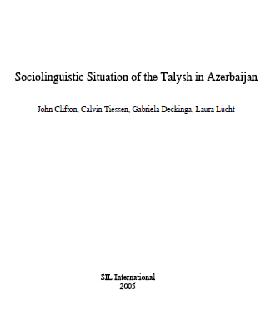 Abstract Abstract
This paper presents the results of sociolinguistic research conducted
between August 1999 and October 2000 among the Talysh people living in
southeastern Azerbaijan. The goals of the research were to investigate
patterns of language use, bilingualism, and language attitudes with
regard to the Talysh, Azerbaijani, and Russian languages in the Talysh
community. Of particular interest are the correlations between patterns
of language use and social isolation. Interviews, observations,
questionnaires, and an Azerbaijani Sentence Repetition Test were
employed.∗
1. Background
The Talysh language is a member of the northwest group of Iranian
languages. Historically, the language and its people are reported to
have roots in the Medes. Talysh is one of at least sixteen languages and
speech varieties in the Tati language group of northwestern Iran and
southern Azerbaijan. Talysh refer to themselves and their language as
‘Tolish’. The origin of the name ‘Tolish’ is not clear but is likely
quite old, predating the migration of the Iranian peoples to the
southwestern shores of the Caspian. |
|
|